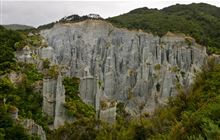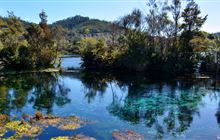Kahurangi National Park
Located in the Nelson/Tasman and West Coast regions
|
Introduction
Located in the northwest corner of New Zealand's South Island, Kahurangi is New Zealand's second largest national park. In places it is an untracked wilderness, elsewhere a wonderful network of tracks lets you explore wild rivers, high plateaux and alpine herbfields, and coastal forests.Find things to do and places to stay Kahurangi National Park
Mangarakau Swamp is a great place to see wetland birds.
Some of the deepest caves in the world have been found in Kahurangi but they are not for the inexperienced.
The Karamea River is prized internationally for its trout fishing.
Remote, wild rivers are a feature of Kahurangi. Most are suitable for experienced kayakers only. Commercial rafting tours are available.
At Mangarakau Swamp you can kayak up Muddy Creek or the Wairoa River at high tide for an enchanting experience.
Visit Mount Arthur area, Cobb Valley or Oparara Basin.
Kahurangi is in the northwest corner of New Zealand's South Island. Motueka, Tākaka, Karamea, Tapawera and Murchison are the park's gateway towns.
Roads from all the gateway towns lead into carparks within the park and a network of tracks.
We recommend 4WD vehicles for the final 2.5 km of the Pearse Valley Road as the road is no longer maintained by the Tasman District Council.
There are regular bus services to Motueka, Tākaka and, in summer, to the start of the Heaphy Track. The bus service through to Christchurch can also drop people at a number of access points into the park. There are also companies in most of the local towns that offer an on-demand shuttle service.
If you are going to be using the track system in the park for overnight trips make sure you are properly equipped and well prepared.
Make sure your group has a capable leader and that everyone is carrying a sleeping bag, cooking utensils, sufficient high energy food (with some extra for emergencies), a waterproof raincoat and overtrousers, gloves, a hat, and several layers of warm (wool or fleece) clothing.
Check at a DOC office for latest information on weather and track conditions.
Weather forecast
Kahurangi National Park weather forecast – NIWA website
Gold fossicking
You can only fossick for gold in designated areas. Only hand-held tools are allowed. More on gold fossicking areas and rules.
Created in 1996, Kahurangi is one of New Zealand's newest national parks, and at 452,002 hectares it is also the second largest.
Translated, its name has a number of meanings including 'treasured possession', an apt description of its wonderfully diverse natural and recreational values.
Geology
Kahurangi is a geologically complex area. Much of its rock is sedimentary, laid down in an ancient sea, then faulted, uplifted and scoured, in places, by glaciers. Parts of the region are limestone or marble, these areas are characterised by an abundance of caves, bluffs, natural arches, sinkholes and water-worn outcrops. New Zealand's oldest fossil (540 million years old) was found in the park.
Vegetation
The vegetation cover changes markedly from one side of the park to the other and from the coast to the tops of mountains. In the east, beech forest is dominant while to the west you will see podocarp forest with a rich understory of ferns, vines and shrubs. On the coast stands of nikau palms give the forest an almost tropical look. 80% of New Zealand's alpine species can be found in the high reaches of the park.
Native animals
Due to the varied landscape numerous different habitats have been created which support many different creatures.
Several threatened species survive here from the diminutive rock wren to one of New Zealand's largest birds - the great spotted kiwi. The park is home to our largest cave spider and the smallest of our giant weta - a flightless insect a bit like a grasshopper.
20 species of carnivorous land snail (Powelliphanta) live in the park; they can sometimes be seen near limestone outcrops though they tend to only come out from hiding on damp nights to feed on native worms that can grow up to a metre long.
Mangarakau Swamp, Westhaven (Whanganui Inlet)
Mangarakau Swamp is relatively pristine freshwater swamp at the southern end of the Whanganui Inlet, south of Farewell Spit on the west coast. Westhaven is one of the largest and least modified estuaries in New Zealand. It was formally protected in 1994 with the creation of the Westhaven (Te Tai Tapu) Marine Reserve and the Westhaven (Whanganui Inlet) Wildlife Management Reserve.
This is a magical location – to the west are tidal bays and inlets and towering limestone bluffs, and to the east the forested ranges of Kahurangi National Park. Take your binoculars as it's a great place to see wetland birds like the Australasian bitterns/matuku-hūrepo and fernbirds/mātā.
To get there, take the road from Collingwood towards Farewell Spit. Turn left at Pakawau Inlet across to the Whanganui Inlet and then follow the road south around the eastern shoreline.
There are toilets and an information centre.
Parts of Kahurangi were occupied by Maori from the 14th century and the coast was much travelled by those seeking pounamu (greenstone).
In 1846 Charles Heaphy, a draughtsman with the New Zealand Company, and Thomas Brunner were the first Europeans to tramp the north west coast of the park.
Later well worn packtracks were built by those wanting easy access to the Aorere goldfield, New Zealand's first gazetted goldfield.
Adams Flat Hut
Adams Flat Hut (1882) is the last of numerous miner huts that once stood near the Fenian Goldfield.
Lord of the Rings
Kuhurangi National Park was a location for Dimrill Dale and the outcrop south of Rivendell in the Lord of the Rings film trilogy.
Contacts
| Whakatū/Nelson Visitor Centre | |
|---|---|
| Phone | +64 3 546 9339 |
| nelsonvc@doc.govt.nz | |
| Address | Millers Acre/Taha o te Awa 1/37 Halifax Street Nelson 7010 |
| Hours | Visitor centre hours and services |



